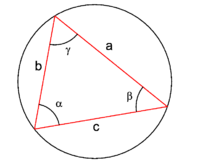Law of sines
In trigonometry, the law of sines (also known as sine rule) relates in a triangle the sines of the three angles and the lengths of their opposite sides,
where d is the diameter of the circumcircle, the circle circumscribing the triangle. The angles and the lengths of the sides are defined in Fig. 1 for an obtuse-angled triangle and in Fig. 2 for an acute-angled triangle.
From the law of sines follows that the ratio of the sines of the angles of a triangle is equal to the ratio of the lengths of the opposite sides.
The rule is useful to determine unknown angles and sides of a triangle in any of the following three cases:
- One side, the opposite angle, and one adjacent angle are given.
- One side and two adjacent angles are given.
- Two sides and an angle not included by the sides are given.
The rule
may have to be applied in such a determination.
The use of the law of sines is complementary to the use of the law of cosines.
Proof of sine rule
The easiest proof is purely geometric, not algebraic.
Lemma: An arbitrary angle with vertex on a circle satisfies (Fig. 3), where d is the diameter of the circle and a is the length of the chord opposite α. To prove the lemma, we construct the angle α' that has the diameter of the circle as one of its sides, and the other side perpendicular to the chord a, see Fig. 3. The opposite angle of d being a right angle, . The two angles, α and α' have the chord a in common and have their vertices on the circumference of the same circle. A well-known theorem of plane geometry states that in that case α = α' , so that it follows that the angle α has the same sine as α'.
Proof: From the lemma follows for the angles in Fig. 4:
where d is the diameter of the circumscribed circle. This proves the sine rule.









